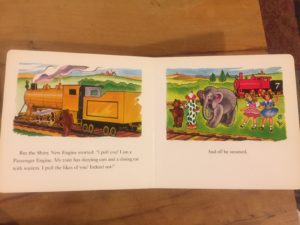![]()
Reading the Little Engine that Could to my toddler for the first time, I stopped short about halfway through. I stared at the book and thought, “The Little Engine that Could is female? Huh.”
Personally, the only thing I remembered before reading it with my kid was that the Little Engine said, “I think I can” a lot. (It was actually a lot less than I remembered.)
As it turns out, the core of the story is a groundbreaking feminist fable. While The Paper Bag Princess rightly gets great feminist cred for flipping the princess story on its head in 1980, the Little Engine that Could was a story about women helping each other and overcoming barriers together 50 years earlier than that. It’s a great little feminist fable for your train lovers of either gender.
The Power of a Female Protagonist
If nothing else, The Little Engine that Could is notable for featuring two major female characters in a book published in 1930. For those who don’t quite remember, the namesake Little Engine must go over the mountain because an engine pulling a train full of “toys and good things to eat for the boys and girls on the other side of the mountain” has broken down. Several other engines reject the toys asking for a ride before the Little Engine finally takes on the task.
The book explicitly genders both the broken-down engine and the Little Engine as female. While the book specifically refers to both as “she,” it refers to all but one of the other trains as “he.” (The book doesn’t provide a pronoun for the “big, strong engine.”) Compare this to Dr. Seuss, who of his 47 main characters had only three female protagonists. Even today, television and movie executives still say that boys won’t go to a movie or buy a toy starring a girl.
Undervaluing the Needs of Children and Families
The book also illustrates how often our society as a whole underserves and denigrates the needs of children, leaving women to do more than their fair share. After the original engine breaks down, a little toy clown jumps off the train to flag down help. Three different trains pass by, each refusing to pull the original train’s cargo.
The first train states that he is too important to bother carrying the food and toys for the children, explaining that he has a dining car with waiters. For me, it’s hard not to connect that to policies that simultaneously cut taxes on corporations while also cutting food assistance for school lunch.
The second train similarly refuses, explaining that they are too powerful to bother. Obviously, they just came from carrying heavy equipment to print newspapers for adults, so feeding children isn’t worth their time or effort.

Seriously, what an ass.
To add insult to injury, the first two trains aren’t even busy with different jobs! They’re headed back to the maintenance yard and just don’t feel like helping. Any women who has ever had to pick up the slack because some guy decided a task wasn’t worth his time can relate. The third train at least has a sympathetic reason for rejecting the clown – he’s too old and tired.
Overcoming the Glass Roundhouse Ceiling
When the Little Engine comes on the scene, she seems uncertain, even hesitant. Although she wants to help, she’s never been over the mountain. But her lack of experience isn’t for lack of effort. Instead, it’s lack of opportunity – she’s only allowed to do switching in the yard. It’s only when another female train needs help and no one else is willing to that she receives her chance.
Of course, everyone knows the ending – through grit, passion, and encouraging words, she gets over the mountain. She proves herself and brings the children on the other side of the mountain good food to eat and toys to play with. In the end, it’s a story of one strong woman finding empowerment by helping out another woman and serving her greater community.
While reading the same book over and over again can be annoying, I almost never groaned when my kid picked up The Little Engine that Could. By the end, I brought her “I think I can”s to life with pride. After all, how many times had I thought the same thing, whether running up a big hill or going into labor during a job interview? I loved that my young son could see a compassionate, hardworking, risk-taking woman in action, even if she had a smokestack.
For more quirky social justice twists on classic children’s literature, check out Why Richard Scarry’s Busytown Has the Worst City Government Ever. For more fun and engaging ways to teach kids kindness and about social justice, sign up for my Five Day Family Kindness Challenge!
Pingback: This week in the Slacktiverse, September 6th, 2015 | The Slacktiverse
Pingback: The Best of 2015 | We'll Eat You Up – We Love You So
Pingback: Nine Awesome Picture Books with Girls as Main Characters | We'll Eat You Up – We Love You So
I love this observation so much and feel the same Shannon! <3
Thanks!